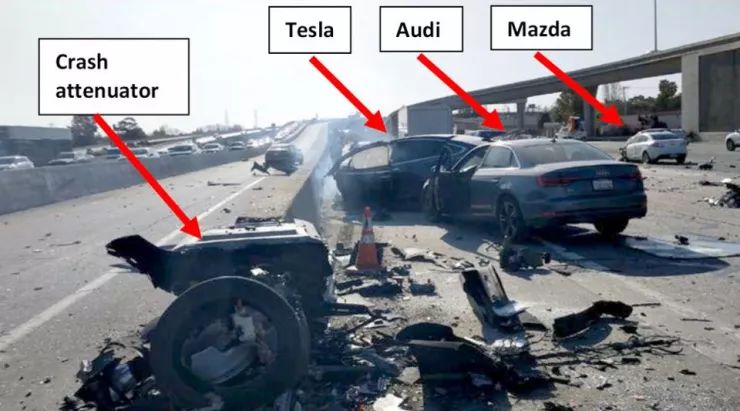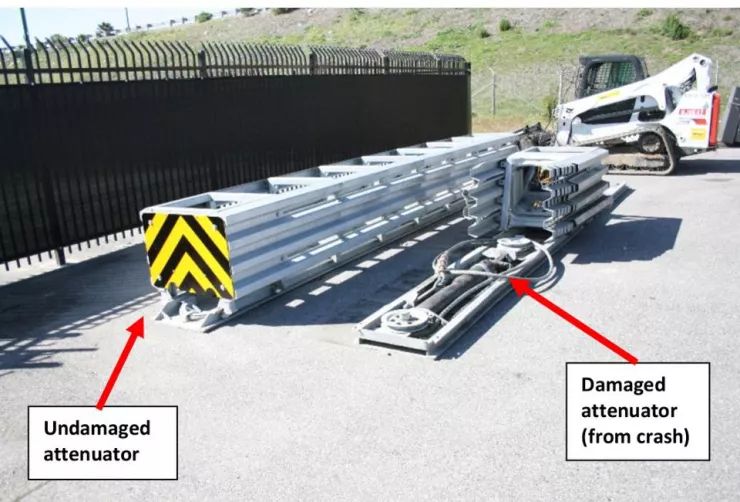Fatal traffic accident, whose responsibility is it?
Editor’s note: This article is from WeChat public account “New Smart Drive” (ID: AI-Drive) author: electric plaster.

Driver Walter Huang assumes primary responsibility
On March 23, 2018, Apple engineer Walter Huang (黄伟伦) drove his Tesla Model X to work and unfortunately caused a fatal accident. His car hit a separation pier at the lower exit of a highway. At that time, Tesla Autopilot was on, but failed to identify obstacles on the road. Even more frightening is that it also controls the vehicle to accelerate as it approaches the separation pier.
In the end, Model X, with its strong passive safety capabilities, failed to save Walter Huang’s life. After the accident, the National Transportation Safety Board (NTSB) began an in-depth investigation into it, and they only recently released an investigation report. On the 25th of this month, there will be a hearing on the NTSB’s full report.
This accident is really frightening. In short, this is a high speed that every Silicon Valley person can’t avoid, and the accident is only a few miles away from Tesla’s headquarters in Palo Alto, so Tesla’s engineers are also regulars on this highway.
Analysis of the entire report shows that NTSB has only moderately added some new data, and almost everyone has guessed the increase. Obviously, Walter Huang made a big mistake and therefore needs to bear most of the responsibilities. After all, Tesla Autopilot is just a driver assistance system, and it still requires driver supervision. Nevertheless, Tesla and the autonomous driving community are interested in the performance of Autopilot and how it can be made better.
In addition to Walter Huang, who is responsible for his own responsibilities, Caltrans, who is responsible for road maintenance, also has responsibilities. Because a few days before Walter Huang’s accident, a car hit the same barrier, but the lucky driver survived. Unfortunately, CaltRans failed to replace the isolation pier in time, otherwise Walter Huang’s chances of surviving will be much higher. Judging from the relevant data, there are quite a lot of collision accidents at the lower crossing of this expressway. It is not known whether Autopilot has evolved the ability to distinguish whether the isolation pier is damaged.
Note that Autopilot may not be held accountable by NTSB’s report. Although it doesn’t perform as magically as it does in the advertisement, Walter Huang knows that Autopilot can’t handle the underpass at high speeds well, because in this position, he encountered at least two problems.
In addition, the report also speculated on what Walter Huang was doing in the last period of time, which does not rule out the possibility that he was playing games on his iPhone at that time. As to whether his hands were placed on the steering wheel as required, the report is also controversial.
What exactly happened that day?
At that time, Walter Huang was driving the autopilot on the road as usual. However, the lane lines on high speeds are a bit fuzzy due to wind and sun, especially the left lane line, which is an important dividing line between the V-shaped lane line and the main road. In fact, if you search on Google, you will find that the lanes here have started to appear blurred in 2016. Obviously Autopilot was “looking away” at the time. It may even see the left side of the V-shaped lane as left The side lane line, and the real left lane line is regarded as the right lane line. Walking along this road and waiting for him is the car crash.
Unfortunately, at that time Walter Huang set a cruising speed of 75 mph (about 120 km / h), but Autopilot slowed down because of the vehicle blocking ahead. However, when this Model X crossed the road, there were no other vehicles blocking it. Autopilot began to guide the vehicle back to 75 mph, but it was not the road ahead, but the concrete isolation pier.
It should be noted that a metal bumper should be placed in front of the concrete isolation pier on the American highway. Once a collision occurs, it will absorb energy to help the car owner to save his life. Unfortunately, the bumper here has been deformed and can no longer absorb energy. In addition, the deformation of the buffer also caused errors in Autopilot target recognition.
Some people would say that the camera is dead. Does n’t Autopilot have a radar? It is true, but the radar recognizes stationary objects, the performance is even worse, otherwise Tesla will not hit the roadside fire truck multiple times.
Is there a “Da Zaba”?
Want to make Autopilot workFrom time to time, the driver must “stress” the steering wheel and tell it that you are still there. If you do not touch the steering wheel for too long, a warning will appear. If the driver continues to ignore, a voice warning will appear, and the vehicle will stop slowly. Generally, after the first stage of visual warning, the driver will turn his attention back.
Autopilot was online for 19 minutes before the collision, but it gave Walter Huang two visual warnings during that time. 2-3 minutes before the collision, Walter Huang released the steering wheel for about 30 seconds. With the visual reminder, he shook the steering wheel again, but the vehicle was still in a “big spread” state 6 seconds before the collision.
Driving games?
There is evidence that Walter Huang was playing the “Three Kingdoms” game while driving, because his iPhone passed data to the game server one minute before the collision, and this game requires two hands to operate.
Of course, the NTSB report does not say whether the game will automatically transfer data in the background. However, if Walter Huang’s driving game is true, then he must be responsible for the accident.
Why the wrong way?
As we all know, with the current level of technology, ambiguous road markings can easily cause errors in the ADAS system, and Walter Huang’s tragedy is also closely related to this. Tesla’s system could have been smarter, but Musk explicitly rejected the technical route of high-definition maps.
If there is a high-precision map, at least the positions of the concrete isolation pier and the collision buffer will be marked. In addition, even if road markings change, bridges rarely change. In other words, this accident could have been avoided.
Heading towards the separation pier?

Apart from going the wrong way, the vehicle’s sensing system was completely disabled at the time. The camera failed to capture a clear picture of the isolation pier, and the radar did not receive an echo. Obviously, Autopilot’s security redundancy is not enough. After the camera malfunctions, the radar will be helpless against stationary objects. In addition to not being good at detecting stationary objects, the resolution of the radar is still very poor. There is almost no resolution in the vertical field of view and the horizontal field of view is only 5 degrees.
If the car is equipped with high-definition maps, it can give the computer at least oneRadar echo estimates and object orientation information. However, even the low resolution of the radar can hinder it at critical moments.
The camera has no resolution problems, but a deformed buffer is not what it can hold. Tesla’s neural network has never seen this “battle”. More importantly, the normal buffer has warning signs with yellow and black stripes, but the deformed one happens to be absent.
After the accident, Tesla also upgraded its system to enhance its ability to detect unknown obstacles. Although computing vision can notice various objects through techniques such as motion parallax, neural networks still have a bit of difficulty recognizing things they have never seen before. Given Musk’s scorn for LiDAR, Tesla’s camera system has a long way to go to cover the entire scene.
In short, no matter who is tuned, the camera + radar combination is now only under ADAS, and it is not considered fully automatic driving.
Who is responsible?
There is no doubt that Walter Huang has to pay for his accidental death, because he knows that Autopilot is incapable of this downfall (he has encountered similar problems twice before). In addition, playing games by car is also his fault. Today’s Autopilot is just an ADAS system, and drivers cannot expect it to be “omnipotent.”
Caltrans, who is responsible for highway management, also needs improvement in work, such as repairing damaged facilities as soon as possible and updating road markings. Unfortunately, these two points are difficult to achieve in reality, so future autonomous driving and ADAS systems must learn lessons and learn to deal with this special situation. Of course, now this V-shaped lane has been repainted, but who knows if similar dangers are hidden elsewhere?
It should be noted that NTSB did not involve Tesla in the investigation of the accident because Musk did not obey NTSB’s management and even hung up the NTSB chairman’s phone. This situation is actually not good for both parties.
From the investigation report, Tesla did not have any responsibility in this accident, but they have many lessons and can be used on the road to fully autonomous driving. After the accident, Tesla upgraded the vehicle’s ability to read blurred lines in a timely manner, and it also improved the detection of static objects. However, the combination of camera and radar still cannot 100% avoid the accident of rear-end stationary objects.
In fact, one year after Walter Huang’s accident, another Tesla chased a truck on the roadside, and the truck was not completely stationary at the time. The NTSB only issued a preliminary report on this accident, but the report did not include what Tesla Autopilot was doing at the time and related information.analysis.
